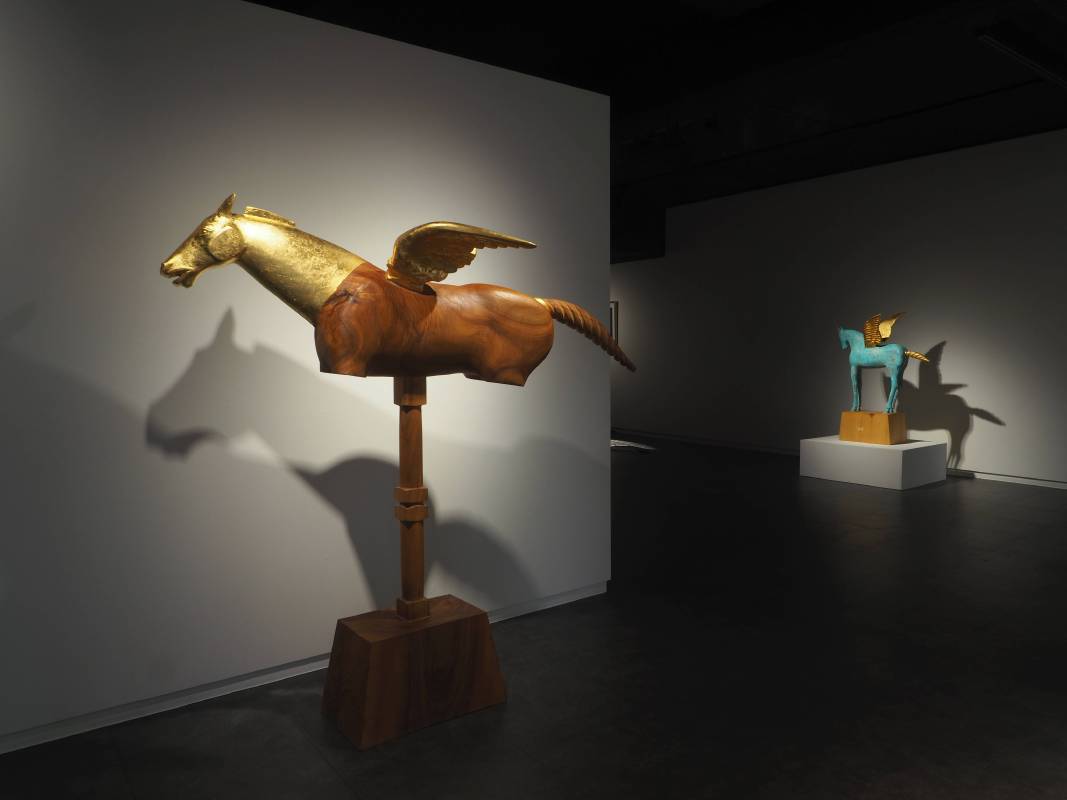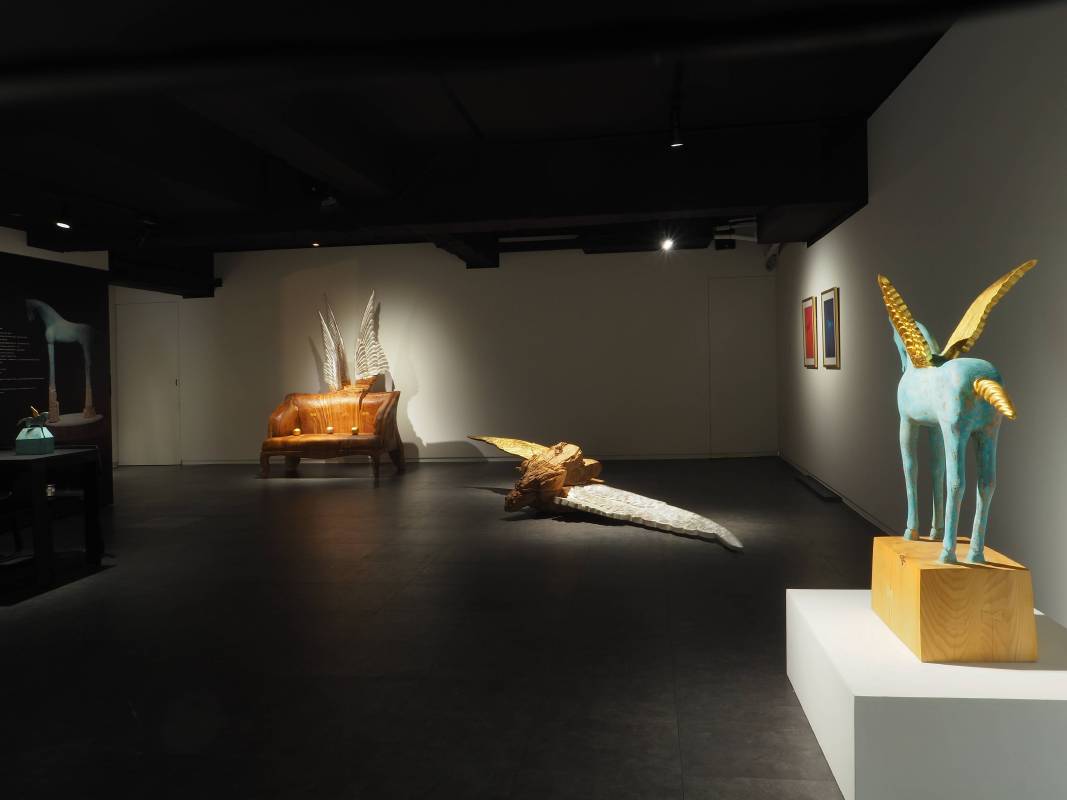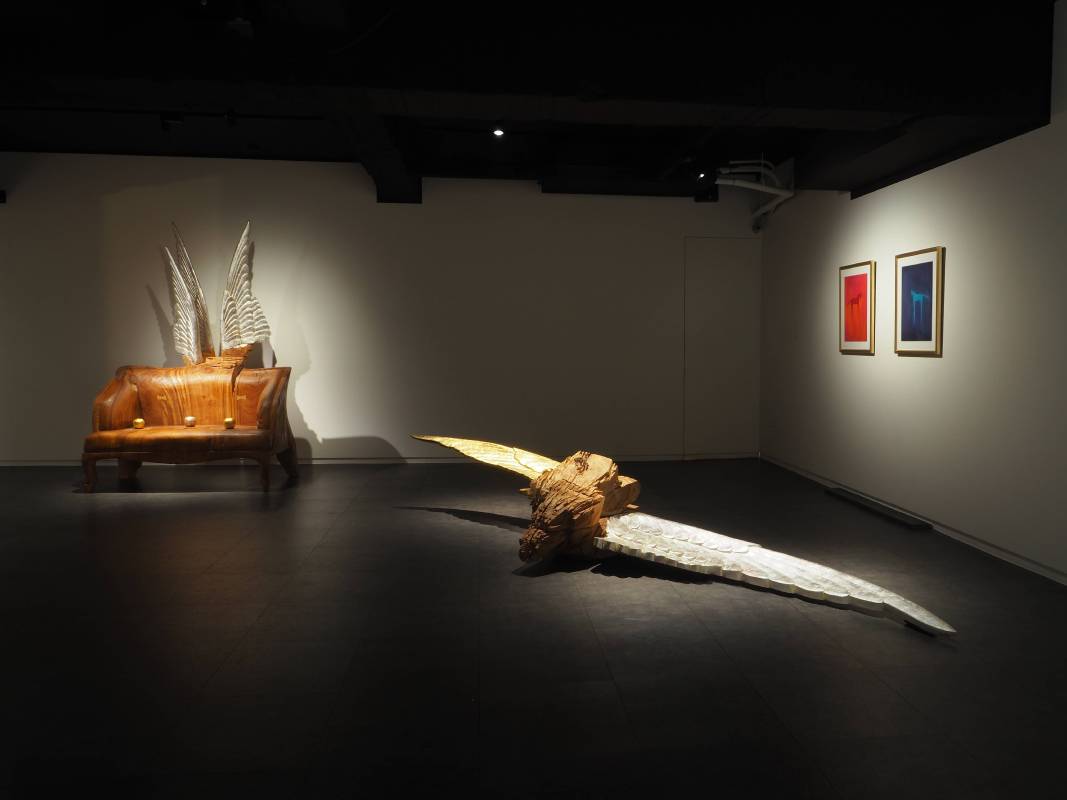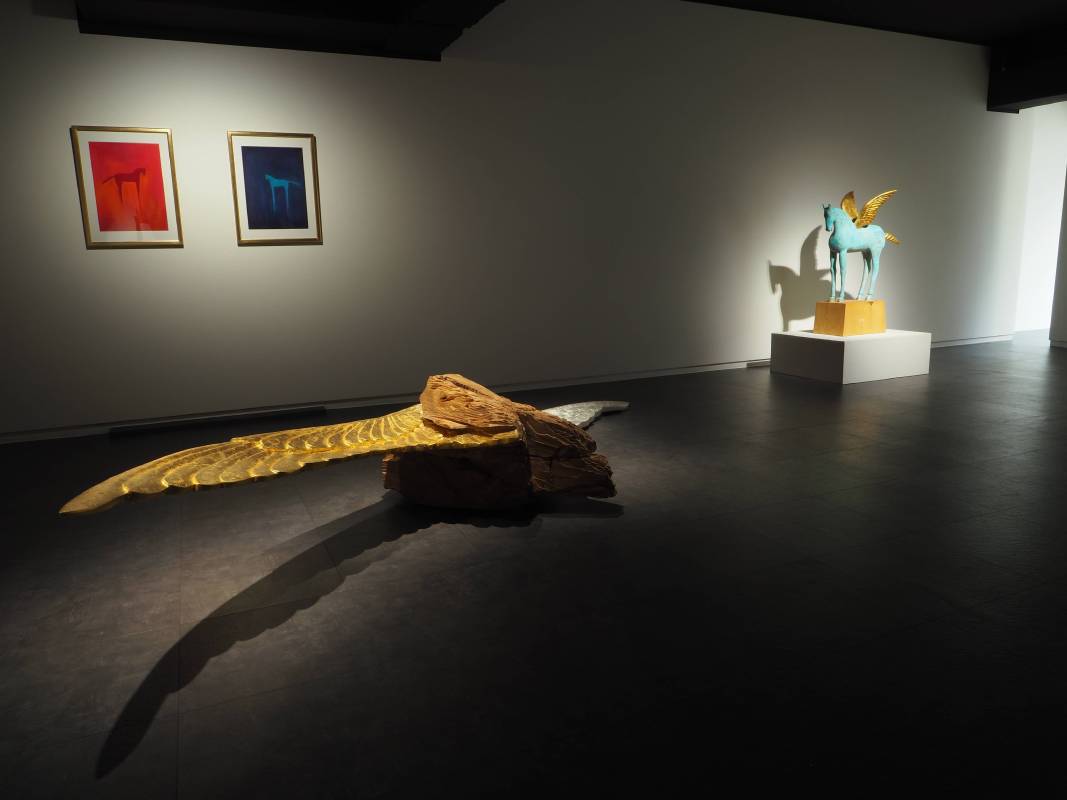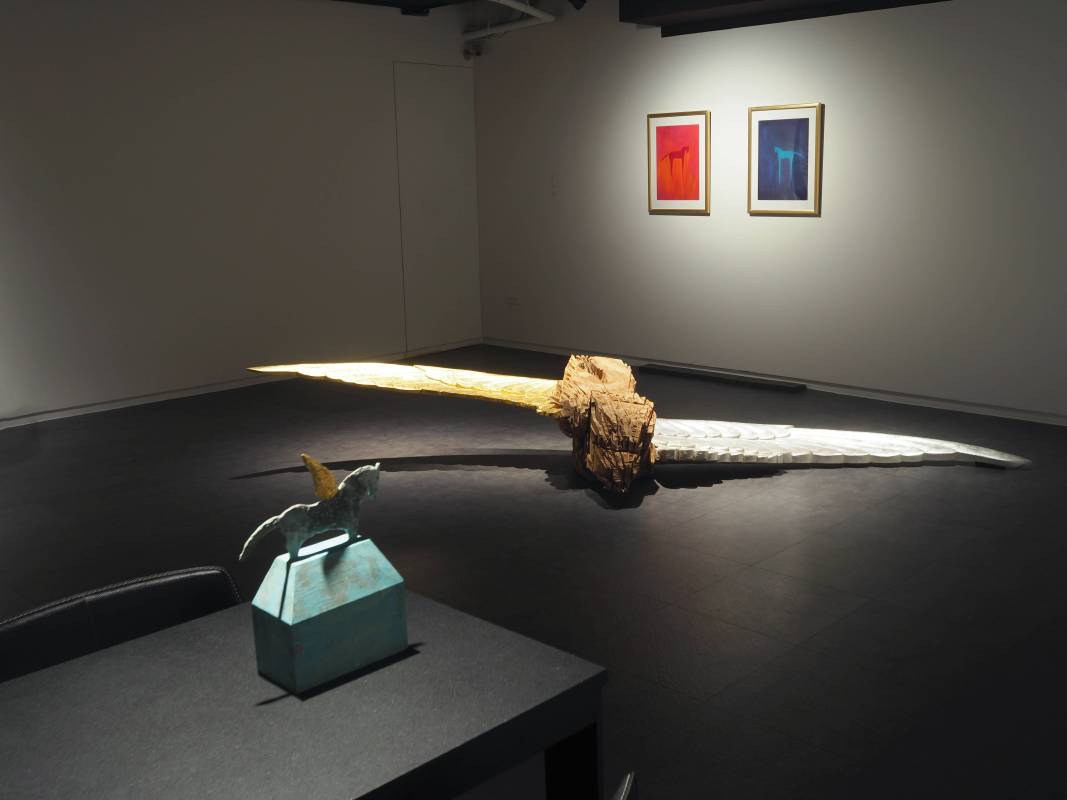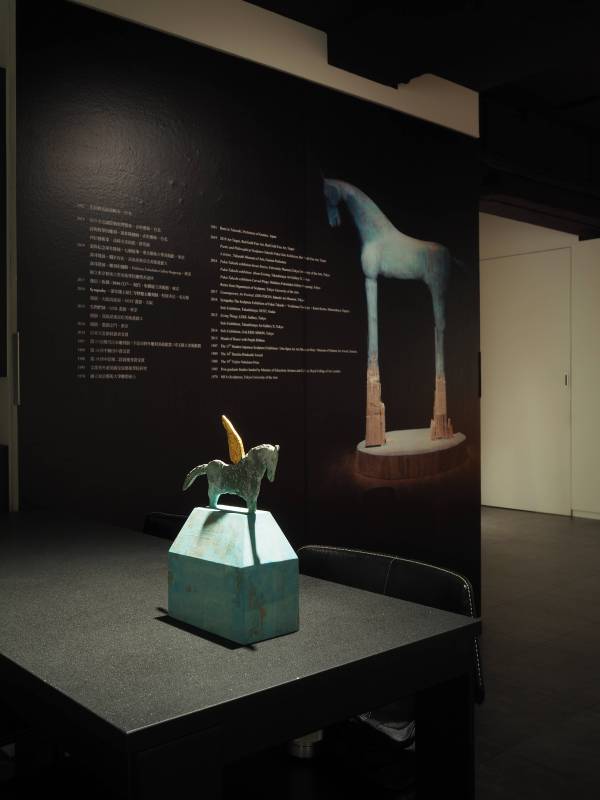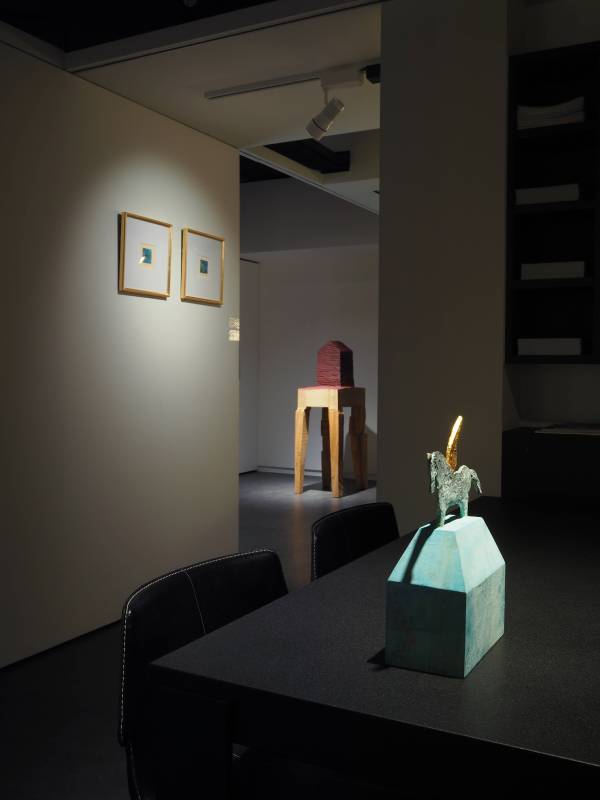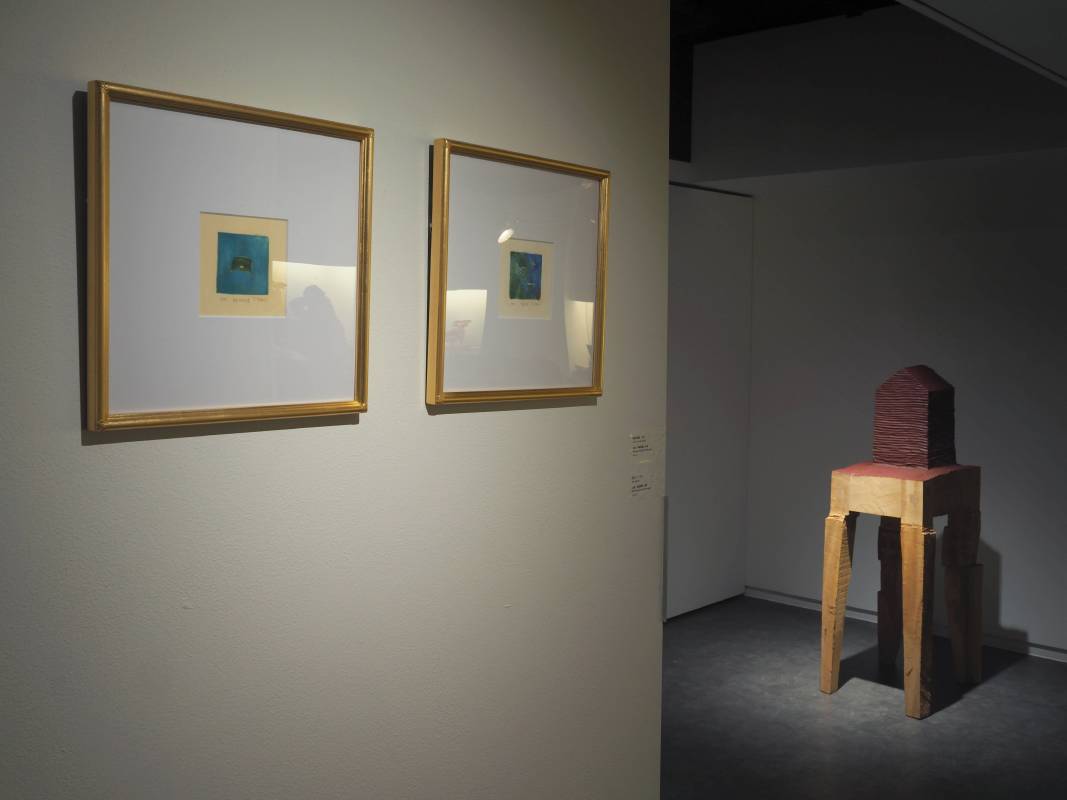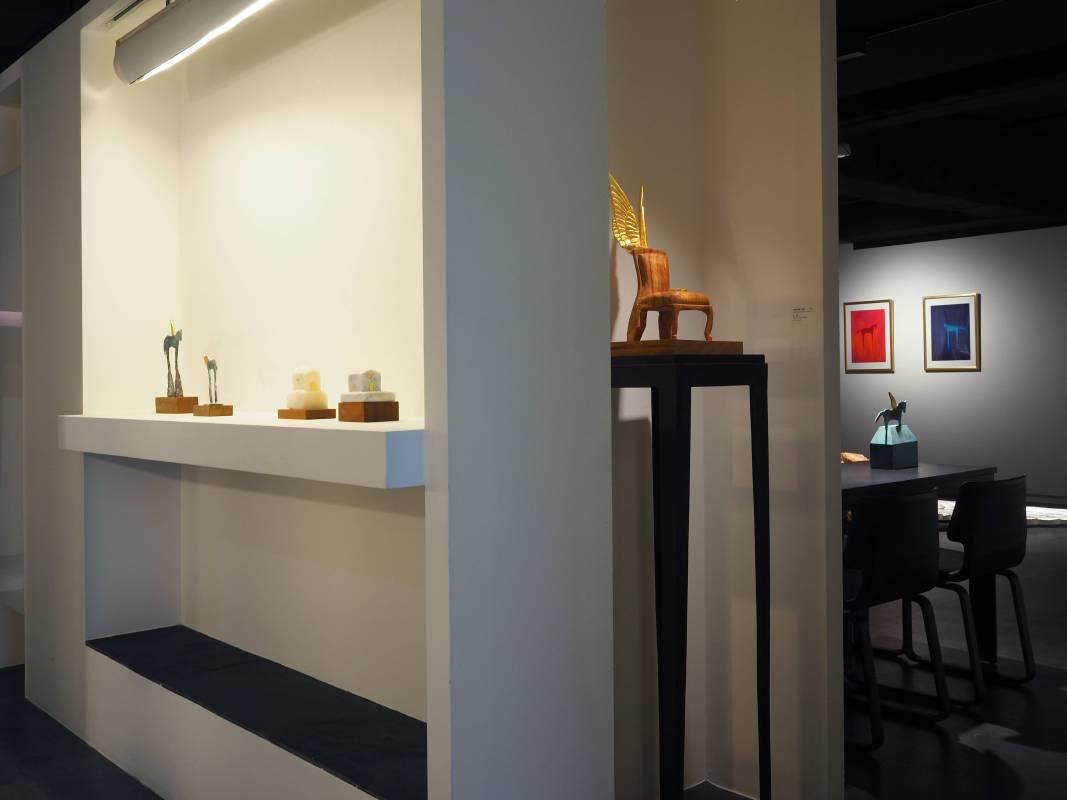赤粒藝術
【詩與哲學的雕刻-深井隆個展 】
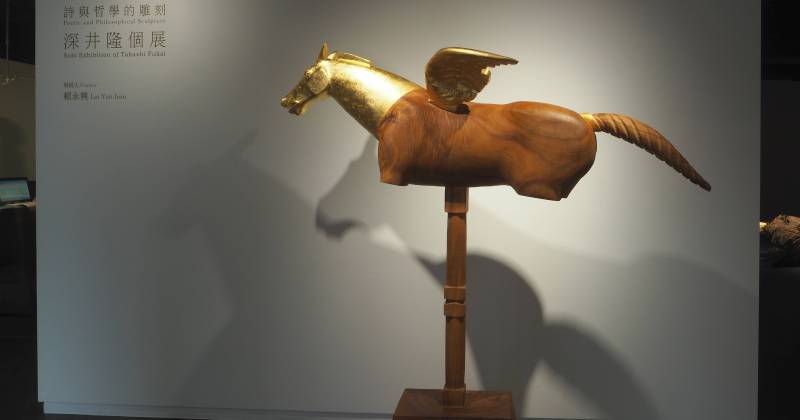
-
詩與哲學的雕刻―深井隆個展
― 用雕刻刀揮灑詩篇的木雕家 ―
印象
幾年前深井隆老師來臺藝大雕塑系交流時帶來了一本深綠色的布面精裝詩集『羊の手 CHRONICLE』,接到手時對這位藝術家竟然也寫詩或者是文學作品而感到敬佩,沒想到一翻開竟是他的編年作品集,覺得他的木雕作品造形極具文學特質,簡直就是一篇篇精彩的現代詩或者是發人深思的哲學短文,雖然書中還是有一篇短詩和三篇散文和他的作品互相輝映。
出身
1951年深井隆出生於群馬縣高崎市,東京藝術大學雕刻科碩班畢業後留校任教直至退休,現任該校榮譽教授,可以說是日本雕塑學院派的代表人物,雖然他的年輕時期面對的是極限主義當道的世界潮流,也曾經嘗試著去創作像極限主義的作品,卻很早的發現那不會是他的路線,一直到受到英國巴里.弗拉納根(Barry Flanagan, 1941 ~2009)、東尼‧克雷格(Tony Cragg, 1949~)、安東尼‧葛姆雷(Antony Gormley, 1950~)等人的影響,他們的創作既不屬於任何派別,又能自由地發揮具有自己的個人特色。這種創作存在的可能性讓他的創作能夠穩定的持續發展。英國皇家藝術學院的研習期間,他有了重新省思自我的機會,以日本精神文化為基盤,西方造形為架構,成就了深井的作品,也是具有不附屬於任何派別,但又具有識別性,對藝術家而言何嘗不是一種理想的狀態。
作品
這次展出作品中「逃逸的思緒」系列大小共有9件,其中有一件「逃逸的思緒―五重奏―」是為了這次個展準備的新作,是貫穿整個創作生涯的主軸。5件是馬的作品,有展翅翱翔的飛馬,也有四條腿被鎖在地面,馬腿卻又向上拉高馬,動態雖然是安定的,但是卻可以感受到一股潛藏的躍動力量。房屋形的作品有木質和石材各2件,簡單的房型加上窄窄的庭園,以「棲」為題,可以感受到深井或是日本人對棲息之地「家」的想望與期待。另有一件壺口展露雙翅的大理石作品,「泉―藍天―」的主題透露出物質與精神的議題。還有版畫及粉彩各兩件,主角都靜謐的定格在空間之中,似乎深井的縱向與橫向的時間在此交織醞釀。
就木雕創作來說深井的木雕是一種不易歸類的存在,早期用樟木刻出椅子的作品開始,這個系列一直延續至今,除了沙發、蘋果、書籍、翅膀之外,也逐漸加入了馬、房屋、圓柱、圓錐、壺、花束等幾種新的題材,除了在作品本身的雕刻刀法俐落,造形掌握簡潔有力之外,作者本身應該隨時意識著作品周遭的場域,或許如此,他的展場空間有一種接近潔癖的空靈感,又或許這是來自日本的禪宗思維再加上深井早年對極限主義的憧憬所致。
材質
關於深井自身與藝術觀感實踐的木雕作品之間的對應關係,日本雕塑評論家酒井忠康曾在一篇評論中寫到「從木頭這種素材的咒縛逃脫,和其他素材對應一事,意味著物質轉化,我卻將之稱為翻譯……,為甚麼呢,在這裡對於詩人而言就像自己的母語一般,對語言有時會變得神經質的情況是一樣的,你(深井) 對木雕堅持是對素材的技術熟練姑且不論,木材的本質所觸發的精神性的作用,是無法忽視的。」。如他所言深井的作品是明顯具有散發出氣場或精神性的特質,雖然雕塑作品或多或少都有這樣的特徵,但是他的作品特別強烈。
說深井的作品是木雕作品,毋寧說是木材質的雕塑來的恰當,木材質之於他的作品是一個理所當然的存在,不論是只上蠟露出木材質原色的表現,或是貼金箔、銀箔或銅箔發銅綠色等或許都是為了壓下木材質的強度,使材質與作品可以達到理想的契合狀態。
時間與空間
雖然深井的作品有翅膀及馬這樣屬於動的題材,但是整個展場氛圍卻是靜態的,深井作品中的時間概念卻是清楚的,分秒為計橫向的時間是流向我們的日常周遭,而縱向的時間則是貫穿過去與未來,而他的作品似乎就是在橫向與縱向時間的交叉處的一個被定格的介面。應該說深井的雕塑是要與周遭的空間一起被觀賞才是成立的,而且近看可以看到純熟的雕刻表現處理及材質之美,當拉開距離遠觀整個展場的當下,這時以人的不在來呈現人的存在這個邏輯,相同的在空間之中彷彿是一個像「門」一樣的概念,其實是被暗喻著它的橫向與縱向的流動與交織是存在於過去與未來之間,這當下只是我們存在的一瞬。
傳承
深井老師的另一個貢獻就是培養出了許多優秀的雕塑家,棚田康司、原真一、土屋仁應……等等,現在在日本藝術界有廣泛影響力,在深井老師的退職展的同時也在東京藝術大學美術館內另一個空間,有一個他與他的學生們的聯展,雖然學生們的創作素材大都以木材為主,但是仍有一些其他材質的作品,甚至跨界的影像創作,而且並沒有發現受到他的造形影響的痕跡。當一個教授的存在變得極大時,他的創作風格沒有出現在學生作品中應該也是他的人格特質所致。
詩
最後分享一首深井在1979年印在他的個展DM上的短詩作為結尾。
「いつもと変わらぬ今日 / 今天還是一如往日
いつもと変わらぬだろう明日 / 明天也會如往昔一樣沒變吧
あるとき / 有時候
そよめく風に、直降する陽光の中に / 在微風中,在直射的陽光裡
いろいろな幻想が顔を出し / 種種的幻想顯現在臉上
自己の内部に変容した日常を発見する / 發現自己內在變遷的日常
一時の流れの中に永遠性を求めようとする刹那 / 片段的時間流之中追尋永恆的剎那
そこに在る日常は何を語りかけてくれるのだろう… / 在那裏的日常或許會對我們訴說著什麼吧…」
Poetic and Philosophical Sculpture – Takashi Fukai Exhibition
– A woodcarver crafts poems with carving knives –
Impression
During a visit at the Department of Sculpture, National Taiwan University of Arts several years ago, Mr. Takashi Fukai brought along a dark green cloth hardcover of collected poems, Sheep’s Hands: CHRONICLE. Upon receiving the book, I was overwhelmed with admiration for the artist who also writes poems or literary pieces. I did not know until later, when opening it, that I found it to be a chronicle of his works. The forms of his wood sculptures amazed me with a literary quality. They were marvelous pieces of modern poetry, or thought-provoking philosophical essays, despite the fact that there were indeed a short poem and three pieces of prose in the book that seemed to complement his sculptures.
Background
In 1951, Fukai was born in Takasaki City, Gunma Prefecture. Before retirement, he had been teaching at the Department of Sculpture, Tokyo University of the Arts ever since graduating from its master’s program. Now as emeritus professor at the university, he can be said to be a representative figure in the Japanese world of sculpture marked by his professional training background. Born into an era when minimalism dominated the world, he had made a few minimalist attempts but realized that it was not his thing at an early age. The works of Barry Flanagan (1941-2009), Tony Cragg (1949- ), Antony Gormley (1950- ) and other British artists exerted an enormous impact on him. They do not fall into any school, and are characterized by a uniquely free, personal style. This artistic possibility inspired him to create on a continuous basis. Further studies at the Royal College of Art, UK, gave him the chance to rethink himself. Fukai pursued art with Japanese spirit and culture as a foundation, and Western form as a structure. Isn’t it, in some ways, ideal for an artist whose works are not attached to any school yet highly distinguishable?
Artworks
One of the series on display at the exhibition, “Dissipating Thoughts” comprises nine works, with Dissipating Thoughts – Quintet newly created for this solo exhibition. This marks one of the most representative series in his artistic career so far. Five of them are about horses: flying winged horses, or those with four legs locked to the ground, yet stretching upwards to their fullest. While remaining static, there is a sense of dynamic force lying behind them. There are also house-shaped works, two made of wood and two of stone. The simple houses are accompanied by narrow courtyards, and the fact that they are named “Sojourn” reveals Fukai’s or Japanese’ longing and expectation for “home,” or a place to sojourn. Furthermore, Spring – Blue Sky is a vessel-shaped marble sculpture with flying wings at the mouth that unveils physical and spiritual meanings. There are also two prints and pastel paintings in which main characters have silently become frozen somewhere in space where Fukai’s vertical and horizontal times converge and evolve.
Fukai’s wood sculptures are hard to categorize. He has been creating chair-shaped camphor wood sculptures from early on all the way through his career. Apart from sofas, apples, books and wings, new subjects ranging from horses, houses, cylinders, cones, vessels to bouquets have gradually been incorporated into his repertoire. His artworks demonstrate great craftsmanship, with the form expressed minimally yet powerfully. The sculpter always seems aware of the spaces around the artworks so that his exhibition areas are ethereal to the extent of being almost mysophobic. Or perhaps it is a result of Japanese Zen thinking, as well as Fukai’s early minimalist aspirations.
Material
As to the relationship between the self and artistic philosophy in Fukai’s practice of wood carving, the Japanese sculpture critic Tadayasu Sakai said in a review, “It is a kind of physical transformation to escape from the shackles of wood as a material in response to other materials, but I would like to call it translation.... Why? To the poet, it is like the mother tongue in that we sometimes get neurotic about the language. Your [Fukai’s] persistence in wood sculptures and technical virtuosity with the material cannot be overemphasized. The spirituality evoked by the nature of wood, too, cannot be overlooked.” As he said, Fukai’s items are obviously permeated with a strong aura or spirituality. This attribute is more or less shared by all sculptures, but manifested most strongly in his works.
I would call Fukai’s works sculptures made of wood as material, rather than wood sculptures. A quintessential part of his art pieces, the wood material is either waxed to bring out its natural wood color, or be covered with gold foil, silver foil, copper foil in copper green or others probably to tone down the strength of the wood material. Both these aim to strike an ideal balance between the material and artwork.
Time and space
Despite the fact that dynamic subjects such as the wings and horses are explored in his works of art, a static ambience can be found in his exhibition venues. There is a clear concept of time in his pieces: The horizontal time calculated by minutes and seconds flows into our daily surroundings, while the vertical time runs into the past and future. His works appear to be perching on a fixed interface at the intersection of horizontal and vertical times. Or we might say that Fukai’s sculptures should be appreciated along with the space around them. At a closer look, you will be impressed by the stunning ingenuity of his carving skills and the beauty of the material itself. Human existence is underscored with human absence in the whole exhibition area, if viewed from some distance. It seems like there is the concept of a “door” within the space, where metaphorical flowing and interweaving of both the horizontal and vertical times exist between the present and future. The now is merely a fleeting moment of our existence.
Passing down
Another contribution Fukai has made as a teacher is that he has trained a great number of remarkable sculptors, including Koji Tanada, Shinichi Hara, Yoshimasa Tsuchiya, etc., all influential figures in the contemporary world of art in Japan. In addition to his retirement exhibition, meanwhile there was a joint exhibition of Fukai and his students hosted at the University Art Museum of Tokyo University of the Arts. While the students’ works were mostly created out of wood, there were still some pieces made of other materials, and even crossover image creations. Above all, none of them showed any hint of influence from him in terms of form. Perhaps it was because of the personality traits of Fukai, a professor with such a prestigious status, that his artistic styles did not creep into his students’ artworks.
Poetry
I would like to end with a short poem by Fukai that had been printed on the flyer of his solo exhibition in 1979.
“いつもと変わらぬ今日 / “Today is like any other day,
いつもと変わらぬだろう明日 / So I guess tomorrow will stay the same, too?
あるとき / Sometimes,
そよめく風に、直降する陽光の中に / In the breeze, under the direct sunlight,
いろいろな幻想が顔を出し / Numerous fantasies play on the face.
自己の内部に変容した日常を発見する / I find my inner self changing with each day,
一時の流れの中に永遠性を求めようとする刹那 / Searching for a moment of eternity within fragmented flows of time.
そこに在る日常は何を語りかけてくれるのだろう… / The daily life there might probably whisper something in our ears.”
推薦藝術家
view all推薦展覽
view all赤粒藝術
【遠山疎樹李茂成個展】Scattered Trees and Distant Mountains: Solo Exhibition of LEE Mau-cheng
日期:2024-06-22 ~ 2024-08-04|台灣,台北市
赤粒藝術
【自然與記憶梁兆熙2024個展】Nature and Remembrance: Solo Exhibition of LIANG Zhaoxi
日期:2024-05-04 ~ 2024-06-16|台灣,台北市

